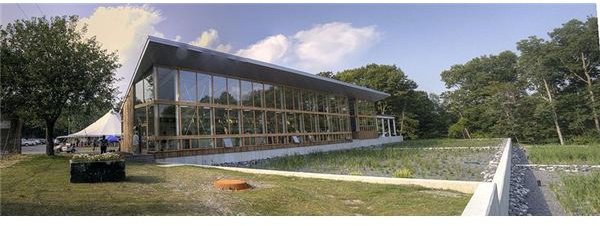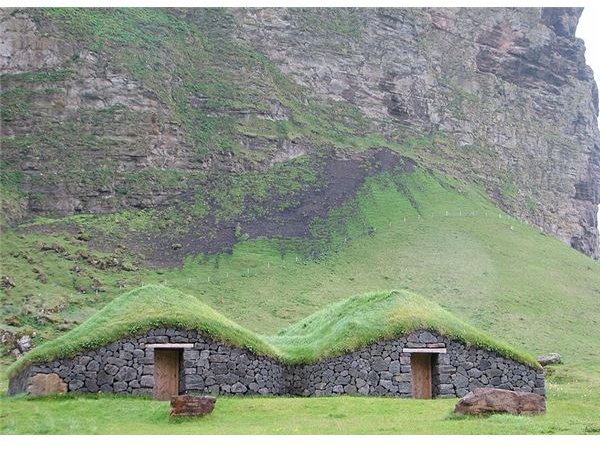The Building as a Living Structure
The concept of the building as a living structure, or like a living creature, refers to building structures that, like living organisms, are attuned to their environment. This is not a new idea. Before the industrial age, it was a common practice for builders to take the regional climate and the topography into account, and to make use of local materials. Generally, this meant that the environment was little impacted from the construction activities, and there was a distinct diversity in international architecture designs, since each had particular unique regional features- for instance, bamboo houses in Cambodia, turf roof houses in Iceland,
and adobe houses in Mexico.
In the industrial age, the machine rather than nature came to inspire builders and they sought to “conquer” or “subjugate” nature to their purpose rather than to seek a harmonious balance with it. Buildings began to be built with little or no concern for local climatic conditions. The buildings had artificial heating and cooling systems, anyway, and building materials began to be sourced from afar if needed. Nowadays it has become common to see the same type of constructions in different regions.
Living Buildings promote Energy Efficiency
The problem with the machine-inspired buildings is that they consume a lot of energy for their upkeep. This energy comes from fossil fuel sources and the supply of fossil fuels, as everyone is now aware, is not unlimited. The widespread use of fossil fuels as well as the sourcing and conveying of building materials, not to mention the construction process itself, has added to the growing problems of pollution and global warming.
These problems have already had a devastating effect on the environment and the climate, and continuing to erect high maintenance buildings will not bode well for the future. With this in mind, many architects and builders now seek to create designs and structures that are more ecologically sound and are either more energy efficient or make use of alternative energy sources like solar, wind and water powered technologies.
Concepts used in Living Buildings
Self-sustaining buildings that operate like a multipurpose ecosystem are the ideal today. Let’s look at some of the criteria that such buildings will need to meet.

-
The building is built from local materials that are renewable, do not degrade the environment, and do not pose a health hazard to humans.
-
The building is built in sync with local environmental conditions. This means, if the climate is hot, the building will be designed to keep its interior cool, and if the climate is cold, the interior will naturally preserve heat. There will be little or no need for artificial temperature control. The building may have an outer membrane that functions like the skin of a living organism in regulating air-flow and temperature. Such a membrane, known as the Self-Activated Building Envelope Regulation (SABER) system, has been developed by Luke Lee and Maria-Paz Guiterrez of the University of California.
-
The building will be solar powered using the bio-mimetic and pollution-free photovoltaic (PV) technology. In this, solar panels convert solar radiation into electricity. These panels can be the large, space-hogging ones that you place on your roof or terrace, or the more convenient panels that can be fitted into the roof or fixed as window panels. The building may also make use of wind and water power technologies.
-
The building will have a rainwater harvesting facility and a system to recycle and reuse waste water. The building may also have a composting toilet. The waste treatment is done without the use of chemicals. Instead, micro-organisms that feed on waste and plants that purify water are used. The waste is moved through tanks containing these for purification and the end result can be reused.
-
The building may have a green roof and/or green walls. This consists of growing various grasses and plants on horizontal and vertical surfaces with inbuilt watering systems. Growing plants on outer surfaces help keep the interiors cool.
-
The building will be multi-functional and aesthetically pleasing in appearance.
Here are some examples of living buildings
The Gutman Visitor Center, Jerusalem
This is a bird research center run by the Society for the Protection of Nature in Israel (SPNI). Situated near the Supreme Court and the Knesset, the center was built of recycled materials, has self-sustaining features, and has a living roof. A living roof is made up of living plants. The building also has spaces for wildlife to make their homes in.
The Omega Center for Sustainable Living, Rhinebeck, NY

This green building is powered by solar energy panels and its temperature is regulated by a geothermal heating and cooling system. It has a rainwater harvesting system and a system for reusing waste water. The building is designed to let in the maximum amount of natural light, reducing the need for electricity.
The EpiCenter, Bozeman, Montana
Built by the National Institute of Standards and Technology (NIST) and Montana State University (MSU), the EpiCenter generates its own non-polluting energy, has a temperature control system, and has a waste recycling system that makes use of an ecological waste treatment plant and a photovoltaic system. There is a solar power system and a fuel cell system that is activated when the solar system does not work at night or in times of insufficient sunlight.
Conclusion
In addition, some designers are exploring the idea of using live, deep-rooted trees like willow or plane trees to construct buildings. The trees are planted close together and the branches are trained in the required directions. If you like the idea of living in a structure that will continue to grow around you, this is the thing to try.
Designing a building like a living creature is good for the environment and will benefit the planet in the long run. However, the concept does not yet enjoy widespread use. There are issues about state building codes that need to be addressed, and people too need to be given more information about the practicability and long-term benefits of living buildings. Many people assume that such constructions will be exorbitantly expensive. This is not always the case and, in fact, making using of alternative energy sources will cut electricity, water and sewage bills and prove to be more cost-effective in the long-term.
References
Cascadia Green Builiding Council - The Living Building Challenge (PDF), Beyond LEED (PDF)
The Living Building - Biomimicry in Architecture, Integrating Technology with Nature - Bob Berkebile, Jason McLennan
Treehugger - First Living Building Successfully “Grown” - Brian Merchant
Images - Wikipedia - Omega Center for Sustainable Living (OCSL), Rhinebeck, New York, Grass Roof Houses, E.V.A.Lanxmeer House
